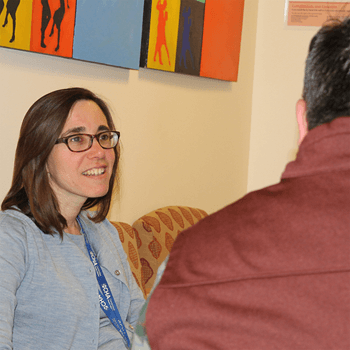Surviving Addiction

Ellie Grossman, MD talks with Phil at CHA Primary Care Somerville Campus.
"I just lost two friends two days ago." Phil's phone cut in and out as he drove through Eastern Massachusetts to his job. He lives in the Boston area but travels to work with his father supporting the family business. "Both of my friends passed because of the stigmas associated with addiction. Medication-assisted treatment needs to be better accepted as an option for people to survive."
Deaths from opioids continue to rise, increasing fivefold since 1999. Over 42,000 people died from overdoses in 2016, and prescription drugs caused 40% of those deaths.
Phil's story began in high school when he started using drugs at 14 – mostly marijuana and alcohol. Someone introduced him to Oxycodone during college in Vermont. At that time, "the magical green pills" made him happier and he was able to maintain his GPA and graduate with a political science degree. Doing drugs was a part of his white, middle/upper-class culture and was socially acceptable in college within his circle of friends. That culture of drug use continued a few years after graduation when he joined a start-up company in Boston. People worked hard and played hard – what many experience as a common start-up culture.
"It was fun. We grew so fast, so quick and it was really stressful," explained Phil. "By then Oxycodone had disappeared and was replaced by little blue pills called Percocet. They were everywhere. They were cheap, and that's when taking them became more than an escape on the weekends." As a functioning addict, Phil continued to do well in his job. He was getting promotions and being recognized for his hard work. When the little blue pills began to disappear, their price sky-rocketed leaving Phil and others searching for cheaper options.
Phil reluctantly turned to heroin, even though the thought of heroin had never crossed his mind. He was now scared. His work performance steadily declined and he secretly started a private treatment program. A life of abstinence and the stigma of being labeled an addict weighed on Phil. Recovery was overwhelming as he tried to manage his addiction, work, secrecy and relationships.
He ultimately overdosed, lost his job, and was filled with guilt. His secret was finally exposed. Losing his job ultimately saved his life, allowing him to focus on recovery.
| |
With the help of CHA, Phil came to realize that, "Life has good moments and bad moments, but our lives are precious."
|
| |
|
Ellie Grossman, MD, met Phil after he was referred to CHA Somerville Primary Care Center. Here, he could access an expanded behavioral health integration program. For over ten years, CHA has partnered with the state to offer Office Based Opioid Treatment (OBOT). This allows CHA providers in almost all primary care locations to prescribe Buprenorphine (also known as suboxone), a medication that removes drug cravings and withdrawal effects – and allows people to return to feeling 'normal.' CHA's program offers addiction-trained nurse case managers to provide additional support to patients who need it.
"For patients who can manage their prescriptions, the OBOT program reduces the stigmas associated with the disease of addiction," said Dr. Grossman. "There are no labels for people walking into their primary care site, it's just a place where people come to get healthy, with all different types of health concerns. CHA offers many treatment options for people so that they can tailor a plan to meet their needs."
It took Phil a few tries to figure out what worked for him, but he's grateful for CHA's substance use and addiction programs that gave him choices. "I started with the Intensive Outpatient Program (IOP) – the approach really helped me mentally. I learned how to accept my emotions without obsessing over them."
"Having structure really helps me," explained Phil. "The support groups, my job – having a routine is great. I also appreciate not having barriers to getting care, letting me define my own sobriety. I appreciate the support my family provides, but it's really up to me to make this work. It's taken me a while to get to this point and I know it's something that I'll have to deal with for a long time."
"There's no magic program where people can be sent away and come back cured of their addiction. It is a chronic disease. That means people will be dealing with this long-term," added Dr. Grossman. "Because of how dangerous opioids are, it's also important for anyone who has an opioid use disorder history or has any kind of opioid in their home to have naloxone or Narcan, an injectable drug that can reverse an overdose, in their home. It's that serious."
The treatment methods offered at CHA are based on scientific research. CHA recognizes that each person's journey is unique and what works best is adjusting to each person's needs. If you know of someone who is dealing with a substance use disorder, please contact your CHA primary care practice, call 617-591-6051.
Disclaimer
This articles provide general information for educational purposes only. The information provided in this article, or through linkages to other sites, is not a substitute for medical or professional care, and you should not use the information in place of a visit, call consultation or the advice of your physician or other healthcare provider.